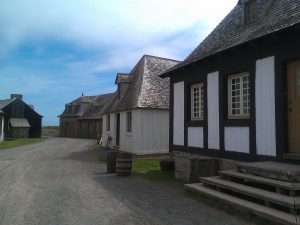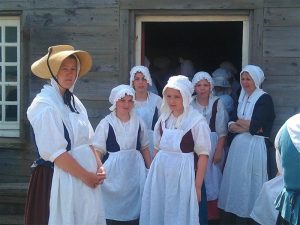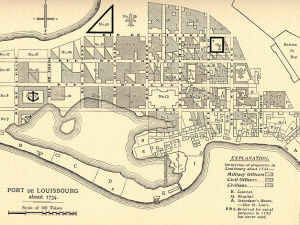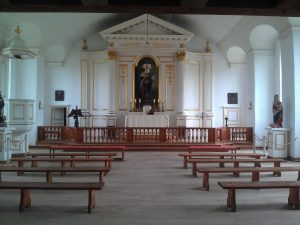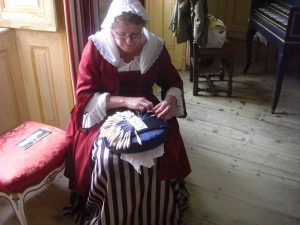Life in the 1748-1758 era in Fortress Louisbourg must have been exciting. While the town of Louisbourg had been first settled in the early 1600s by the French, its importance grew during the late 1600s and early 1700s as the British and French competed for control of the region. For the British it was probably a desire to expand their influence and holdings spreading from New England. For the French it was the lucrative fishery resources and protection of their trade and communication routes between France, Quebec, and the West Indies. The Treaty of Utrecht in 1713 gave the British control over the peninsular Acadia while the French retained control over adjacent Ile Royale (Cape Breton Island).
I visited Fortress Louisbourg in 2011 and all of the photos here were from that visit.
A siege in 1745 by New Englanders backed by the British was successful in taking control over Ile Royale and Louisbourg, but to the disgust of the New Englanders Ile Royale was returned to France in 1748, as part of events on a larger scale involving Europe. This set the stage for the French to return to Louisbourg to rebuild the city and its fortifications, which also gave rise to the need for people with all kinds of skills, including my great-great-great-great-great grandfather, Charles Violet, a roofer.
Louisbourg in those times was a bustling city. From a report in Wikipedia: “Louisbourg was a large enough city to have a commercial district, a residential district, military arenas, marketplaces, inns, taverns and suburbs, as well as skilled laborers to fill all of these establishments. For the French, it was the second most important stronghold and commercial city in New France. Only Quebec was more important to France. The population of Louisbourg quickly grew. In 1719, 823 people called this maritime city their home. Seven years later, in 1726, the population was 1,296, in 1734 it was 1,616, and by 1752, the population of Louisbourg was 4,174. Of course, population growth did not come without consequences. Smallpox ravaged the population in 1731 and 1732, but Louisbourg continued to grow, especially economically.” (http://en.wikipedia.org/wiki/Fortress_of_Louisbourg)
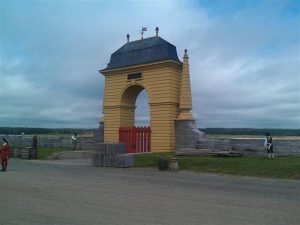
The Louisbourg Gate is a smaller version of the Gate at Versailles, so the King would feel at home should he ever visit Louisbourg
But while it might seem that Louisbourg was a cosmopolitan city, there was no question that it existed as a result of a royal decision. Much of the city’s design and many of its features had in mind impressing King Louis XV should he ever decide to visit (he never did). The entrance to Louisbourg from the harbor was the Gate, built to emulate the Gate at Versailles. The main street leading from the harbor, Rue Toulouse, was a generous 30 pieds (roughly 32 feet) wide where most of the other streets were 24 pieds (roughly 25.5 feet) wide. This would provide a broad way for the King to travel from the harbor to the Parade Ground and the King’s Bastion up the hill. There were stock pens and food items such as chickens raised to always be in readiness for His Majesty’s dining pleasure.
And there was no question about the hierarchy in Louisbourg, either, as the map at left shows. The military occupied the central portion of the city in its barracks, armories, and other support buildings. Three and one quarter miles of walls surrounded the fortified city. Houses at prime locations along Rue Toulouse and adjoining blocks were occupied by the eight Captains in the military; each Captain commanded a troop of 70 soldiers, for a total of 560 men. Plus, there were 40 in the artillery. Parallel with the military were the civilian administration officials. The Governor, the Administrator, the Engineer, and others in the hierarchy also had grand homes in the central district. Other buildings in the central district housed inns and business establishments. Only those with noble family ties were allowed to be officers in the military and to occupy the higher posts. The “blue-bloods” were allowed to walk down the center of the streets and all others had to walk along the sides, in fear of punishment. Walking at the sides had its hazards, however, as toilet and other wastes were dumped from windows and out doors of buildings along the streets, and you were in danger of being dumped on as well as having to walk through all the ordure.

A house garden at Capt de Gannes residence; many kept small garden to partially supply their own needs.
Louisbourg was laid out in 30 rectangular blocks with the buildings constructed at the edge of the block lines. Several buildings were built along any block face and they were allowed to use common walls with neighbors. Thus, one enterprising store owner was able to build his building between two adjoining buildings by only constructing two walls – one for the front and one for the back! But, except for the hospital and maybe one other larger building, the buildings did not occupy their entire lot, and behind the buildings would be garden areas and outdoor living space for residences.
Fishing was the main business in Louisbourg, though, and a major reason for its existence. Roman Catholics were required to abstain from eating meat on about 145 days a year, which meant fish was an important staple in their lives. As populations grew it became more and more difficult find enough fish off the European coasts to satisfy those demands so when reports came from explorations by Jacques Cartier and others about the abundant stock of cod and other fish in the north Atlantic enterprising fishermen sought to capitalize on this. Cod was especially attractive because when salted cod does not lose its nutrients and you only need to soak the salted cod in water to restore its food value. They could catch cod, salt it on board the fishing boats, and then return to France with their catch in about six weeks. But this soon became uneconomical because of the time lost by the fishing fleet in traveling between the fishing areas and the demand areas. So fishing towns were established and the processing of the catch was done there and stockpiled for delivery to Europe in larger vessels carrying larger loads. This left the smaller fishing vessels to concentrate on their jobs. In its heyday, Louisbourg shipped as much as 16,000,000 pounds of cod in peak periods such as just before Lent – a 40-day period of abstinence from meat.
A key port in France was La Rochelle, which is roughly at the same latitude as Louisbourg. This made the La Rochelle-Louisbourg route one of the shortest across the Atlantic, enhancing Louisbourg’s position and importance. The other major capitol for France was Quebec City, up the St Lawrence River from Louisbourg at its mouth. And another major trade center was the West Indies further south. Ships could travel between the West Indies and Louisbourg and between Quebec and Louisbourg easily, and then cross to France by a short route. So Louisbourg became the center of this Golden Trade Triangle.
When France developed its colonies a decree was made that there would be no manufacturing in the colonies, so that all manufactured goods would come from France. This, of course, greatly benefited the merchants and trades in France. And, it further increased the importance of a major shipping point such as Louisbourg, since goods would come from France to Louisbourg and then go to Quebec and to the West Indies.
But Louisbourg’s days soon came to an end, when another siege in 1758 – this time by the British – wrested control from the French. All the French were required to leave and thus my ancestor Charles that I mentioned at the start took his wife and returned to France. As a note, this was not the same wife he came over with, for Marie-David died at Fortress Louisbourg in 1751 and Charles married Marie-Anne Sudois shortly thereafter and she returned to France with him. The two boys – François Violet and Alexis Hilaret – stayed behind. Charles had had to declare bankruptcy in 1751 and his two boys were assigned to subrogate guardians and thus stayed with them. It is François that is my direct ancestor, and it is he who ended up in the Upper St John River Valley and established the Violette family in this region. Alexis, child of Marie-David’s first marriage, ended up in the West Indies, where he died in 1765 at age 32.


